It looks like you're using an Ad Blocker.
Please white-list or disable AboveTopSecret.com in your ad-blocking tool.
Thank you.
Some features of ATS will be disabled while you continue to use an ad-blocker.
share:
A recently released image from NASA's photo journal (link) inspired me to once again
review some of the more noteworthy rover images we've acquired up to now in order to compare them to similar fossilized features here on Earth.
Although the stitch is composed of images that have already been taken on sol 39 of Opportunity's mission, I think it's worth reinvestigating them. Here goes the rock formation from the photo journal (with features of interest highlighted in yellow):
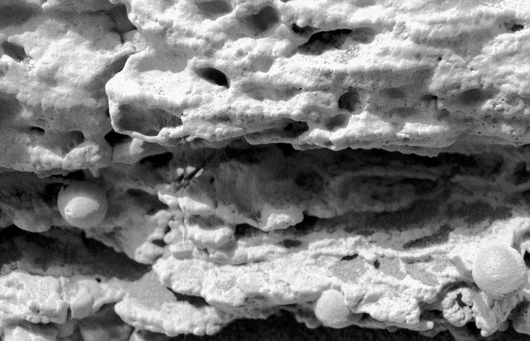 Fullsize
Fullsize
This was added to the journal on 28 November 2014 with the title "Clues to Wet History in Texture of a Martian Rock". The long & segmented features as well as the round'ish spherules in the lower half are IMO rather intriguing. They compare incredibly well to terrestial crinoids (plant-like marine animals) and a certain genus of cystoids which I will outline more in detail further below. Moreover, the segmented parts are also highly reminiscent of Richard Hoover's infamous 'fossil' which had been ground to dust in the early days of Opportunity's mission:
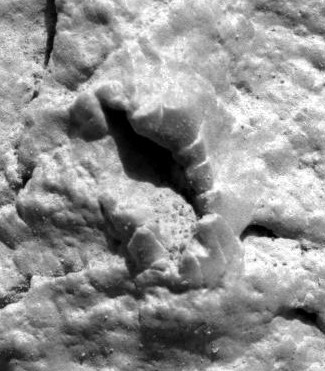 Source
Source
 Source
Source
I think the last image above explains pretty well why Hoover and others were 'not amused' when NASA/JPL decided to use the rock-abrasion-tool (RAT) to grind the rock in order to see what the surface below is made of. IMO, there clearly is an amazing similarity between fossilized devonian crinoids and the features seen in the images from Mars.
In order to understand how striking the resemblance is, it helped me to look at actual fossils from Earth and the anatomy of crinoids in particular. Here's a diagram showing the different elements of a crinoid:
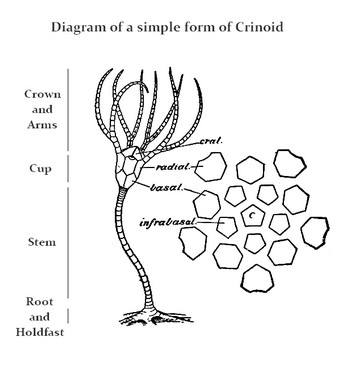 Image Source
Image Source
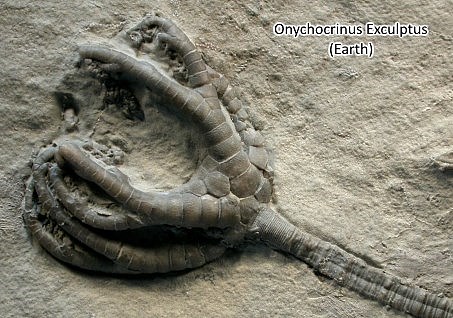
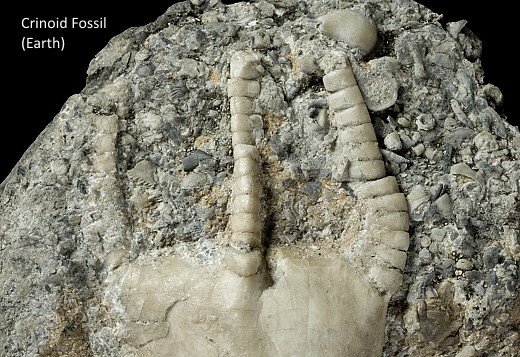
For comparison, check here and here to again see the similarities regarding the typical segmentation of the crown arms in crinoid fossils.
Now it's very interesting to note that the 'spherules' can be seen in the same image and area. They seem to resemble fossilized Echinosphaerites, an organism that used to thrive during the early and middle Ordovician period on Earth:
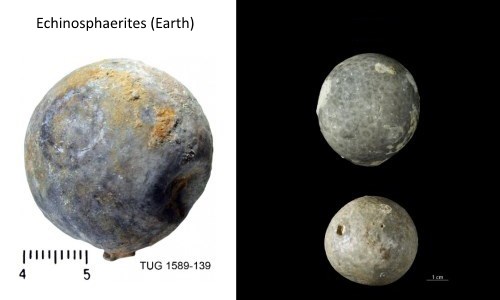

Here goes some information about the kind of environments in which Echinosphaerites / Cystoids have been found on Earth:
And as if that wasn't enough: crinoids have so-called 'holdfasts' on the ground which are pretty unique in shape. Are we surprised that Curiosity recently imaged quite a few of these 'holdfasts'? Not really, I guess ... here's a comparison of terrestial crinoid holdfasts (top) and their possible martian counterparts (bottom):
 Source Images: Sol 617
| Sol 137
Source Images: Sol 617
| Sol 137
So while again reviewing all these images, I realized that the evidence for crinoidal lifeforms in the martian past is actually pretty good, if not even overwhelming. We've identified 3 separate elements on Mars which closely resemble devonian fossils on Earth. Additionally, we know that Mars once had considerable amounts of water on its surface. So even if NASA/JPL have been holding back for quite some time now (ever since these images have been acquired), I think it's really difficult to explain all this away as a pure coincidence (or random geological concretions). Especially when considering Curiosity's recent findings that martian bodies of water have lasted much longer on the surface than previously thought, the case for past life on Mars IMO becomes more and more plausible!
Thanks for reading up to here and I'm very much looking forward to your thoughts on this ... !
Sources & Links:
---------------------------------------------------------
01.Opportunity Sol 39 Close-Up 01
02.Opportunity Sol 39 Close-Up 02
03. Opportunity Image Archive Sol 39
04. NASA Photo-Journal PIA18885
05. Summary on 'Enterprise-Mission'
06. Sol 34 Close-Up of Potential Crinoid Remains
07. Article on Mars Fossils by M. Davidson
08. Terrestial Echinosphaerite Fossils
08. Echinosphaerite (Overview Page)
10. More information on crinoid fossils
11. Image-catalog of crinoids
Although the stitch is composed of images that have already been taken on sol 39 of Opportunity's mission, I think it's worth reinvestigating them. Here goes the rock formation from the photo journal (with features of interest highlighted in yellow):

This was added to the journal on 28 November 2014 with the title "Clues to Wet History in Texture of a Martian Rock". The long & segmented features as well as the round'ish spherules in the lower half are IMO rather intriguing. They compare incredibly well to terrestial crinoids (plant-like marine animals) and a certain genus of cystoids which I will outline more in detail further below. Moreover, the segmented parts are also highly reminiscent of Richard Hoover's infamous 'fossil' which had been ground to dust in the early days of Opportunity's mission:


I think the last image above explains pretty well why Hoover and others were 'not amused' when NASA/JPL decided to use the rock-abrasion-tool (RAT) to grind the rock in order to see what the surface below is made of. IMO, there clearly is an amazing similarity between fossilized devonian crinoids and the features seen in the images from Mars.
In order to understand how striking the resemblance is, it helped me to look at actual fossils from Earth and the anatomy of crinoids in particular. Here's a diagram showing the different elements of a crinoid:



For comparison, check here and here to again see the similarities regarding the typical segmentation of the crown arms in crinoid fossils.
Now it's very interesting to note that the 'spherules' can be seen in the same image and area. They seem to resemble fossilized Echinosphaerites, an organism that used to thrive during the early and middle Ordovician period on Earth:


Here goes some information about the kind of environments in which Echinosphaerites / Cystoids have been found on Earth:
Echinus aurantium: Locations
Environments: marine, transition zone/lower shoreface, shallow subtidal, deep subtidal shelf, carbonate, coastal, offshore, offshore shelf, reef, buildup or bioherm, foreshore, peritidal, offshore ramp.
And as if that wasn't enough: crinoids have so-called 'holdfasts' on the ground which are pretty unique in shape. Are we surprised that Curiosity recently imaged quite a few of these 'holdfasts'? Not really, I guess ... here's a comparison of terrestial crinoid holdfasts (top) and their possible martian counterparts (bottom):

So while again reviewing all these images, I realized that the evidence for crinoidal lifeforms in the martian past is actually pretty good, if not even overwhelming. We've identified 3 separate elements on Mars which closely resemble devonian fossils on Earth. Additionally, we know that Mars once had considerable amounts of water on its surface. So even if NASA/JPL have been holding back for quite some time now (ever since these images have been acquired), I think it's really difficult to explain all this away as a pure coincidence (or random geological concretions). Especially when considering Curiosity's recent findings that martian bodies of water have lasted much longer on the surface than previously thought, the case for past life on Mars IMO becomes more and more plausible!
Thanks for reading up to here and I'm very much looking forward to your thoughts on this ... !
Sources & Links:
---------------------------------------------------------
01.Opportunity Sol 39 Close-Up 01
02.Opportunity Sol 39 Close-Up 02
03. Opportunity Image Archive Sol 39
04. NASA Photo-Journal PIA18885
05. Summary on 'Enterprise-Mission'
06. Sol 34 Close-Up of Potential Crinoid Remains
07. Article on Mars Fossils by M. Davidson
08. Terrestial Echinosphaerite Fossils
08. Echinosphaerite (Overview Page)
10. More information on crinoid fossils
11. Image-catalog of crinoids
edit on 14-12-2014 by jeep3r because: formatting
originally posted by: jeep3r
This was added to the journal on 28 November 2014 with the title "Clues to Wet History in Texture of a Martian Rock". The long & segmented features as well as the round'ish spherules in the lower half are IMO rather intriguing. They compare incredibly well to terrestial crinoids (plant-like marine animals) and a certain genus of cystoids which I will outline more in detail further below. Moreover, the segmented parts are also highly reminiscent of Richard Hoover's infamous 'fossil' which had been ground to dust in the early days of Opportunity's mission:
That picture is the one Hoover was talking about. He seems pretty certain about it, and anyway why'd they pick that particular object to do a Jeremy Clarkson on... to look for carbon, it had obviously caught their attention in the first place.
I find this whole thing pretty fascinating.
edit on 14-12-2014 by smurfy because: Text.
a reply to: smurfy
I have to admit that I only got really fascinated about this find when I took a good look at the crown and arms of terrestial crinoid fossils. The segmentation and shape is really very specific, almost too 'specific' to be caused by random erosion IMO.
Add in the spherules/cystoids (also marine in nature), the holdfasts and viola: we've got the basic foundation of an early marine ecosystem on Mars ... now all we need is some more input and data from Curiosity so that we can substantiate all our interpretations!
I have to admit that I only got really fascinated about this find when I took a good look at the crown and arms of terrestial crinoid fossils. The segmentation and shape is really very specific, almost too 'specific' to be caused by random erosion IMO.
Add in the spherules/cystoids (also marine in nature), the holdfasts and viola: we've got the basic foundation of an early marine ecosystem on Mars ... now all we need is some more input and data from Curiosity so that we can substantiate all our interpretations!
edit on 14-12-2014 by jeep3r because: text
it's naive to think there wasn't/isn't life on Mars
there is probably life on all planets
my question is what kind of life besides human
we havent seen much online about the other planets
there is probably life on all planets
my question is what kind of life besides human
we havent seen much online about the other planets
a reply to: jeep3r
Great job, that was some jolly good sleuthing.
Assuming this evidence is proven to be genuine, it could be a shot in the arm for the Panspermia theory. The resemblance is uncanny and since there was not much biodiversity in Earths early oceans (forgive me I don't know my Devonian from my Silurian) these organisms could share the same heritage.
I get the sense that it is only a matter of time before we find something.
Great job, that was some jolly good sleuthing.
Assuming this evidence is proven to be genuine, it could be a shot in the arm for the Panspermia theory. The resemblance is uncanny and since there was not much biodiversity in Earths early oceans (forgive me I don't know my Devonian from my Silurian) these organisms could share the same heritage.
I get the sense that it is only a matter of time before we find something.
The shape and general appearance of the proposed crinoid fossil on Mars is enough like those known on Earth to be intriguing. However, it is also true
that appearances, even fairly complex ones, can me misleading.
Supporting data of other sorts than form and appearance alone would be necessary to make a really compelling case for fossils on Mars. Such work is probably beyond the capabilities, remarkable though they are, of the Curiosity rover.
On the encouraging side, there is this to consider: Graptolites. These are fossils of simple, colonial life forms, typically appearing like stalks arranged in a fan-like configuration. These were once written off as mere accidental scratches on rocks. Further work finally established that they were the preserved remains of once-living things.
Supporting data of other sorts than form and appearance alone would be necessary to make a really compelling case for fossils on Mars. Such work is probably beyond the capabilities, remarkable though they are, of the Curiosity rover.
On the encouraging side, there is this to consider: Graptolites. These are fossils of simple, colonial life forms, typically appearing like stalks arranged in a fan-like configuration. These were once written off as mere accidental scratches on rocks. Further work finally established that they were the preserved remains of once-living things.
edit on 14-12-2014 by Ross 54 because: improved paragraph structure
edit on
14-12-2014 by Ross 54 because: corrected misspelled word
edit on 14-12-2014 by Ross 54 because: corrected misspelled word
originally posted by: smurfy
originally posted by: jeep3r
This was added to the journal on 28 November 2014 with the title "Clues to Wet History in Texture of a Martian Rock". The long & segmented features as well as the round'ish spherules in the lower half are IMO rather intriguing. They compare incredibly well to terrestial crinoids (plant-like marine animals) and a certain genus of cystoids which I will outline more in detail further below. Moreover, the segmented parts are also highly reminiscent of Richard Hoover's infamous 'fossil' which had been ground to dust in the early days of Opportunity's mission:
That picture is the one Hoover was talking about. He seems pretty certain about it, and anyway why'd they pick that particular object to do a Jeremy Clarkson on... to look for carbon, it had obviously caught their attention in the first place.
I find this whole thing pretty fascinating.
The chose this spot in particular because this is where the giant Martian temple is; just out of view.
a reply to: jeep3r
Just how long ago is 'recent bodies of water' ?
the old rule of thumb was that water & atmosphere was present on Mars about a Billion ears Ago
the anomalies you show with their earth counterparts could not possibly be a billion years old fossils....so......
with earth fossils being 100s of millions years old (in general)''we could possibly assume that water borne life was present on Mars ---say -> as late as 400 million years ago...
I think the erosion/sandblasting taking place on Mars is very much more destructive than on Earth fossils...so that brings the 'recent' creation of fossils on Mars closer to 100-150 million years ago, at least to my less than sterling determination of fossil age
150 mya Mars had a few rare Oasis' of waterborne life in sheltered & optimal water-borne pools, a kind of live which evolved in a state of harsh living in extreme environments...
yes ...
but no Edgar Rice Burroughs Rainforest Mars Scape...
...Especially when considering Curiosity's recent findings that martian bodies of water have lasted much longer on the surface than previously thought, the case for past life on Mars IMO becomes more and more plausible! ...
Just how long ago is 'recent bodies of water' ?
the old rule of thumb was that water & atmosphere was present on Mars about a Billion ears Ago
the anomalies you show with their earth counterparts could not possibly be a billion years old fossils....so......
with earth fossils being 100s of millions years old (in general)''we could possibly assume that water borne life was present on Mars ---say -> as late as 400 million years ago...
I think the erosion/sandblasting taking place on Mars is very much more destructive than on Earth fossils...so that brings the 'recent' creation of fossils on Mars closer to 100-150 million years ago, at least to my less than sterling determination of fossil age
150 mya Mars had a few rare Oasis' of waterborne life in sheltered & optimal water-borne pools, a kind of live which evolved in a state of harsh living in extreme environments...
yes ...
but no Edgar Rice Burroughs Rainforest Mars Scape...
edit on 12/14/2014 by tothetenthpower because: (no reason given)
a reply to: St Udio
Mars is not Earth and has not been anything like Earth for a very long time.
There isn't so much sandblasting as there is dustblasting, a slow process.
I think the erosion/sandblasting taking place on Mars is very much more destructive than on Earth fossils
Mars is not Earth and has not been anything like Earth for a very long time.
There isn't so much sandblasting as there is dustblasting, a slow process.
www.abovetopsecret.com...
In contrast to these relatively fast, short-term erosion rates, average erosion rates on Mars determined mostly from deflation of landing sites over ~100 Myr and 3 Gyr timescales from the literature are of order 0.01 m/Myr or less, which is 3-4 orders of magnitude slower than the slowest terrestrial rates determined over similar timescales. The similarity of these average erosion rates together with the long spatiotemporal scales of averaging involved in their estimation, argues they are representative of the true long-term process rate.
Yes, less than sterling. You seem to assume that the "fossils" would begin eroding as soon as they were formed, before they had become exposed by erosion.
so that brings the 'recent' creation of fossils on Mars closer to 100-150 million years ago, at least to my less than sterling determination of fossil age
edit on 12/14/2014 by Phage because: (no reason given)
a reply to: jeep3r
An excellent presentation, rare on ATS!
Do they have a certain timetable to get to the revelation of life on the planet? To recognize that ploy, all we need to do is be aware of how the acknowledgement of water on that planet has been suggested time and time again as if they forgot this month what they intimated or virtually said last month. All the while we are gnashing our teeth over the fact that some of the very first images gave signs of water!
An excellent presentation, rare on ATS!
Do they have a certain timetable to get to the revelation of life on the planet? To recognize that ploy, all we need to do is be aware of how the acknowledgement of water on that planet has been suggested time and time again as if they forgot this month what they intimated or virtually said last month. All the while we are gnashing our teeth over the fact that some of the very first images gave signs of water!
a reply to: Aliensun
Both Earth and Mars formed about 4.5 billion years ago, along with the rest of the Solar System. Because Mars is significantly smaller than Earth it would have cooled faster but taking into account the bombardment of the planets by other bodies in the early solar system neither would have been considered conducive to life for quite a while.
It took the first life about 0.7 billion years to show up on Earth. That tells us that the Earth had pretty much cooled down by then.
Mars may have had a bit of a head start (but it sort of tripped about half way down the course when it lost most of its water and atmosphere). But not enough to allow much time for higher life forms to evolve. It took about 4 billion years for the first plants to show up on Earth. Mars was dried out long before that.
Both Earth and Mars formed about 4.5 billion years ago, along with the rest of the Solar System. Because Mars is significantly smaller than Earth it would have cooled faster but taking into account the bombardment of the planets by other bodies in the early solar system neither would have been considered conducive to life for quite a while.
It took the first life about 0.7 billion years to show up on Earth. That tells us that the Earth had pretty much cooled down by then.
Mars may have had a bit of a head start (but it sort of tripped about half way down the course when it lost most of its water and atmosphere). But not enough to allow much time for higher life forms to evolve. It took about 4 billion years for the first plants to show up on Earth. Mars was dried out long before that.
a reply to: Phage
What about the cambrian explosion some 540 mya? Until then, life on Earth was more or less restricted to very primitive organisms (most of them very simple, composed of individual cells etc.). How much evolution did actually take place in the billions of years prior to that event?
Then something happened and there was a boost to biological entities on Earth and complex life evolved with a high rate of diversification. That's why I think it's difficult to guestimate how long life takes (ultimately) to evolve into more complex forms. Perhaps the situation on Mars was different ... again: difficult to say IMO.
What about the cambrian explosion some 540 mya? Until then, life on Earth was more or less restricted to very primitive organisms (most of them very simple, composed of individual cells etc.). How much evolution did actually take place in the billions of years prior to that event?
Then something happened and there was a boost to biological entities on Earth and complex life evolved with a high rate of diversification. That's why I think it's difficult to guestimate how long life takes (ultimately) to evolve into more complex forms. Perhaps the situation on Mars was different ... again: difficult to say IMO.
a reply to: jeep3r
It's also difficult to guesstimate how long it takes for life to actually start at all. Perhaps it never did happen on Mars. Perhaps it did.
Granted, we have only one model. We only know it happened here and we have a pretty good idea of how long it took. We know that by the time there were plants on Earth, Mars had dried up.
That's why I think it's difficult to guestimate how long life takes (ultimately) to evolve into more complex forms. Perhaps the situation on Mars was different
It's also difficult to guesstimate how long it takes for life to actually start at all. Perhaps it never did happen on Mars. Perhaps it did.
Appearances can be deceptive, and many geological formations can look like fossils.
Concretions, bubbles, and stuff like that can look organic. For example, here's a rock on the Moon that was examined by the Apollo moon walkers:
www.hq.nasa.gov... It's covered with some bubbly melt material on one side.
As Ross 54 mentioned, we need a larger body of evidence to consider that these may be fossils. Curiosity is examining the past habitability of Mars, and has already found signs of a habitable environment. NASA's next Mars rover will actually search for signs of past life. Then, hopefully, the search for past life on Mars will move beyond simply looking at pictures and saying "that looks like a fossil."
Mars' time-scale doesn't give much hope, though. On Earth, it took billions of years for single-celled organisms to appear, and another couple of billion years for multicellar organisms. At best, Mars could have supported colonies of single-celled organisms, and they might have built some structures or left some imprint in the rocks and sediment.
As Ross 54 mentioned, we need a larger body of evidence to consider that these may be fossils. Curiosity is examining the past habitability of Mars, and has already found signs of a habitable environment. NASA's next Mars rover will actually search for signs of past life. Then, hopefully, the search for past life on Mars will move beyond simply looking at pictures and saying "that looks like a fossil."
Mars' time-scale doesn't give much hope, though. On Earth, it took billions of years for single-celled organisms to appear, and another couple of billion years for multicellar organisms. At best, Mars could have supported colonies of single-celled organisms, and they might have built some structures or left some imprint in the rocks and sediment.
a reply to: wildespace
That pseudofossil link is interesting. I used to split open old basaltic rocks when I was a kid looking for "fern fossils".
That pseudofossil link is interesting. I used to split open old basaltic rocks when I was a kid looking for "fern fossils".
originally posted by: wildespace
Appearances can be deceptive, and many geological formations can look like fossils. Concretions, bubbles, and stuff like that can look organic. For example, here's a rock on the Moon that was examined by the Apollo moon walkers: www.hq.nasa.gov... It's covered with some bubbly melt material on one side.
These 'carpet rocks' are totally enigmatic IMO ... interesting links, by the way. I acknowledge that visual evidence is not sufficient in terms of finding 'proof'.
Although, in my defence, I have to point to the fact that the crown arm segments and cystoids in one image both strengthen the notion that this might be 'more' than pure geology at work. The holdfasts, although found at a different location, also seem to point to marine organisms in certain areas on Mars.
So I agree, this is not (yet) proof. But we've collected a great many indicators for potential past life on Mars!
edit on 14-12-2014 by jeep3r
because: text
new topics
-
Is the origin for the Eye of Horus the pineal gland?
General Conspiracies: 47 minutes ago -
Man sets himself on fire outside Donald Trump trial
Mainstream News: 58 minutes ago -
Biden says little kids flip him the bird all the time.
2024 Elections: 1 hours ago -
The Democrats Take Control the House - Look what happened while you were sleeping
US Political Madness: 1 hours ago -
Sheetz facing racial discrimination lawsuit for considering criminal history in hiring
Social Issues and Civil Unrest: 1 hours ago -
In an Historic First, In N Out Burger Permanently Closes a Location
Mainstream News: 3 hours ago -
MH370 Again....
Disaster Conspiracies: 4 hours ago -
Are you ready for the return of Jesus Christ? Have you been cleansed by His blood?
Religion, Faith, And Theology: 6 hours ago -
Chronological time line of open source information
History: 7 hours ago -
A man of the people
Diseases and Pandemics: 9 hours ago
top topics
-
Israeli Missile Strikes in Iran, Explosions in Syria + Iraq
World War Three: 17 hours ago, 19 flags -
In an Historic First, In N Out Burger Permanently Closes a Location
Mainstream News: 3 hours ago, 14 flags -
The Democrats Take Control the House - Look what happened while you were sleeping
US Political Madness: 1 hours ago, 8 flags -
Thousands Of Young Ukrainian Men Trying To Flee The Country To Avoid Conscription And The War
Other Current Events: 14 hours ago, 7 flags -
Iran launches Retalliation Strike 4.18.24
World War Three: 17 hours ago, 6 flags -
12 jurors selected in Trump criminal trial
US Political Madness: 17 hours ago, 4 flags -
4 plans of US elites to defeat Russia
New World Order: 10 hours ago, 4 flags -
A man of the people
Diseases and Pandemics: 9 hours ago, 4 flags -
Man sets himself on fire outside Donald Trump trial
Mainstream News: 58 minutes ago, 4 flags -
Biden says little kids flip him the bird all the time.
2024 Elections: 1 hours ago, 3 flags
active topics
-
Thousands Of Young Ukrainian Men Trying To Flee The Country To Avoid Conscription And The War
Other Current Events • 25 • : twistedpuppy -
Silent Moments --In Memory of Beloved Member TDDA
Short Stories • 46 • : Encia22 -
Man sets himself on fire outside Donald Trump trial
Mainstream News • 8 • : BernnieJGato -
12 jurors selected in Trump criminal trial
US Political Madness • 73 • : ImagoDei -
The Democrats Take Control the House - Look what happened while you were sleeping
US Political Madness • 15 • : matafuchs -
Are you ready for the return of Jesus Christ? Have you been cleansed by His blood?
Religion, Faith, And Theology • 17 • : TheValeyard -
Israeli Missile Strikes in Iran, Explosions in Syria + Iraq
World War Three • 100 • : Astrocometus -
Biden says little kids flip him the bird all the time.
2024 Elections • 5 • : TheValeyard -
President BIDEN Warned IRAN Not to Attack ISRAEL - Iran Responded with a Military Attack on Israel.
World War Three • 46 • : ImagoDei -
"We're All Hamas" Heard at Columbia University Protests
Social Issues and Civil Unrest • 131 • : marg6043
